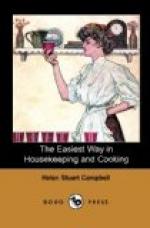So many adulterations are found in ground coffee, that it is safest for the real coffee-lover to buy the bean whole. Roasting is usually more perfectly done at the grocers’, in their rotary roasters, which give every grain its turn; but, by care and constant stirring, it can be accomplished at home. Too much boiling dissipates the delicious aroma we all know; and the best methods are considered to be those which allow no boiling, after boiling water has been poured upon it, but merely a standing, to infuse and settle. The old fashion, however, of mixing with an egg, and boiling a few minutes, makes a coffee hardly inferior in flavor. In fact, the methods are many, but results, under given conditions, much the same; and we may choose urn, or old-fashioned tin pot, or a French biggin, with the certainty that good coffee, well roasted, boiling water, and good judgment as to time, will give always a delicious drink. Make a note of the fact that long boiling sets free tannic acid, powerful enough to literally tan the coats of the stomach, and bring on incurable dyspepsia. Often coffee without milk can be taken, where, with milk, it proves harmful; but, in all cases, moderation must rule. Taken too strong, palpitation of the heart, vertigo, and fainting are the usual consequences.
Cocoa, or, literally, cacao, from the cacao-tree, comes in the form of a thick seed, twenty or thirty of which make up the contents of a gourd-like fruit, the spaces between being filled with a somewhat acid pulp. The seeds, when freed from this pulp by various processes, are first dried in the sun, and then roasted; and from these roasted seeds come various forms of cocoa.
Cocoa-shells are the outer husk, and by long boiling yield a pleasant and rather nutritious drink. Cocoa itself is the nut ground to powder, and sometimes mixed with sugar, the husk being sometimes ground with it.
In Chocolate—a preparation of cocoa—the cocoa is carefully dried and roasted, and then ground to a smooth paste, the nuts being placed on a hot iron plate, and so keeping the oily matter to aid in forming a paste. Sugar and flavorings, as vanilla, are often added, and the whole pressed into cakes. The whole substance of the nut being used, it is exceedingly nutritious, and made more so by the milk and sugar added. Eaten with bread it forms not only a nourishing but a hearty meal; and so condensed is its form, that a small cake carried in traveling, and eaten with a cracker or two, will give temporarily the effect of a full meal.
In a hundred parts of chocolate are found forty-eight of fatty matter or cocoa-butter, twenty-one of nitrogenous matter, four of theobromine, eleven of starch, three of cellulose, three of mineral matter, and ten of water; there being also traces of coloring matter, aromatic essence, and sugar. Twice as much nitrogenous, and twenty-five times as much fatty matter as wheaten flour, make it a valuable food, though the excess of fat will make it disagree with a very delicate stomach.




